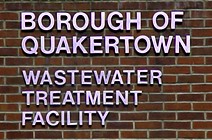 |
 |
Lake Nockamixon. A Pennsylvania state park offers swimming (public pool), sailing and other boating opportunities. How do you know that it is safe for you to in contact with the water? Who knows what's in there and how do we know the lake is safe?
HISTORY OF LAKE NOCKAMIXON WATER QUALITY & HIGH NUTRIENT LEVELS
Even prior to construction of Lake Nockamixon, the Department of Environmental Resources (now the Department of Conservation and Natural Resources) and other involved agencies recognized that the lake would be subject and very vulnerable to high nutrient loading and the development of eutrophic conditions (rich in dissolved nutrients but seasonally deficient in oxygen). This could lead to the deterioration and destruction of lake water quality and have disastrous impacts upon aquatic plants and animals.
High levels of nutrients entering the lake, particularly phosphorus, encourage excessive growth of algae. This algae growth affects all lake users. As it rots it uses great quantities of oxygen needed for aquatic life. It stresses fish populations and also zooplankton that is the base of the food chain. Excess algae also creates odor problems which discourages swimming and reduces overall enjoyment of the lake.
During summer months, Lake Nockamixon experiences thermal stratification (layering based on temperature) of its waters as do most large reservoirs. Dissolved oxygen in the bottom water is depleted as a result of bacterial decomposition of nutrients entering the lake and the decay of algae. In the past during the summer and early fall, no dissolved oxygen was available in Lake Nockamixon at water depths below 12 feet. Viable habitats for lake fish species were restricted to the upper lake levels where oxygen remained to support life. The depletion of dissolved oxygen and increased levels of ammonia in bottom water tends to reduce the quality of water released from the reservoir into the downstream sections of the Tohickon Creek. In a recent study of the lake (2000), dissolved oxygen levels in August were found to be 2mg/L, a slight improvement from original data.
IMPROVEMENTS
The Department of Environmental Resources (DER) had conducted a series of studies to identify the source of nutrient loadings entering the lake and identify strategies for reducing nutrient loads. The Department of Environmental Protection is the agency which studies water quality in Pa. at the present time.
Visible improvements in the water quality of Lake Nockamixon began with the upgrade of the Quakertown sewage treatment facility. The water was possibly polluted by the Quakertown Sewage Treatment Plant. The extent of the damage was discovered in 1974. Since then, the problem has shown significant improvement. Now the plant has an advanced technology system which does not allow dangerous toxins to leak into the lake.
 |
 |
Some of the main pollutants which had damaged the water quality include phosphates and nitrates from fertilizers. They were reported by the DER to be responsible for 28% of the total phosphorus load on the entire lake. Significant sources of fertilizers in the watershed came from erosion of crop land, runoff containing excess commercial or natural fertilizers, runoff and improper disposal of waste from animal holding areas, and the concentration of animals along stream banks contributing to erosion and direct deposition of manure to stream waters.
Septic leaks from the neighboring farms and developments are also believed to contribute to lake pollution. Malfunctioning on-lot septic systems were believed to account for 7 - 8 % of the phosphorus loading in the Nockamixon watershed. Because of shallow depths of bedrock, high water elevations, and impermeable soils, many areas of the watershed have severe limitations from traditional septic systems. These disposal problems were addressed by the existing rules by municipal sewage officers, working with Bucks County Health Department. Older, improperly functioning systems were phased out and replaced with more modern and effective designs.
The continued work on reducing nutrient loading on the watershed will further improve the water quality of Lake Nockamixon.
As part of the park environmental education programming, lake water quality monitoring is conducted by park staff, volunteers and local school groups. For more information on this project contact the environmental education specialist at the park office.
|
|
|
|
|
|
|